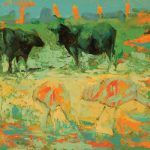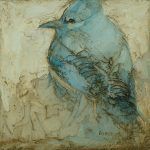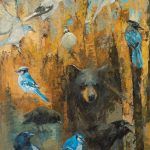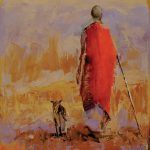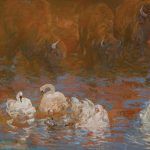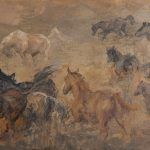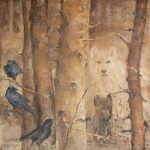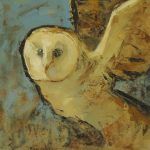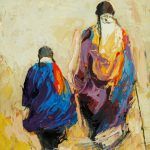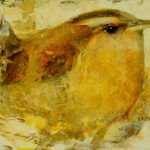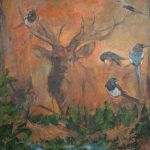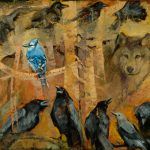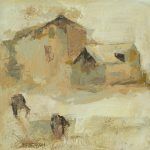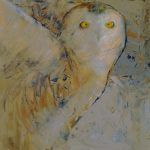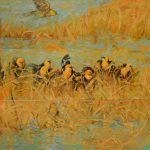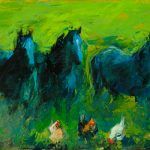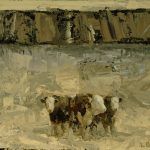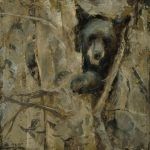Mary Roberson’s paintings celebrate creative freedom
By Gussie Fauntleroy
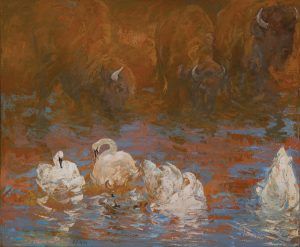
Mary Roberson, Tranquility, oil, 50 x 60.
This story was featured in the September 2016 issue of Southwest Art magazine. Get the Southwest Art September 2016 print issue or digital download now–then subscribe to Southwest Art and never miss another story.
As a young woman in art school in the late 1960s, Mary Roberson found herself confronted with instructors who were unable to see past a certain artistic status quo. “You cannot paint that way; it’s not the norm,” she was sternly told. At the same time, other teachers were highly encouraging. “You’re very creative,” they said. “What you’re doing is great!” Looking back, the 68-year-old painter remembers feeling confused about who she was, especially in relation to art. “It took me years to say: Who cares if I’m being rebellious or if I’m being creative,” she recalls. She now understands, without a trace of self-judgment, that she was both. Yet for all the times her defiant nature seemed to upstage her better judgment, it was art that kept her going through difficult periods in her life. Art was her constant, if sometimes hidden, best friend.
“I was angry, rebellious, humorous, and kind—all of that,” Roberson says, describing herself as a child and young adult. She was also intensely independent-minded, spontaneous, and
gifted with enormous artistic talent—and she still is those things. Now, though, she has the equanimity and self-acceptance to follow her own creative path, regardless of how much it diverges from the norm. And the response to her art over the past 25 years says she’s definitely on the right track; her work is in the permanent collections of the National Museum of Wildlife Art, the Booth Western Art Museum, and numerous private collections around North America and beyond.
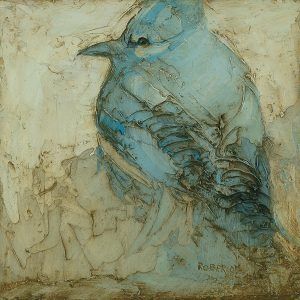
Mary Roberson, Blue Jay, oil, 8 x 8
Roberson’s home and studio, where she has lived for 35 years, sits in a quiet residential
neighborhood in the south-central Idaho town of Hailey. It’s a part of the state where mountains meet high desert, accessible to the wildness of Yellowstone and Glacier National Parks. Such places provide abundant inspiration for her wildlife imagery, which includes grizzly bears, elk, deer, wolves, and buffalo. When she’s out in the wilderness, Roberson uses a high-powered spotting scope to watch animals, and then she “blind sketches” what she sees through the scope—not looking at her sketchpad but rather relying on her hand’s learned intelligence. And while large wildlife is thrilling, she says, the spark of excitement that finds its way onto her canvas can come from anywhere. “I’m inspired by my own yard—by beneficial insects, birds, caterpillars. Even though I don’t paint
caterpillars,” she says with a smile.
Even as a girl, Roberson was inspired to draw and paint what she saw around her, which at the time were seascapes and people. Raised in Redondo Beach, CA, she received strong support for her love of art from her parents. Her father, a baker and later a toolmaker and contractor, built her a painting studio and took her to see a Van Gogh exhibit and other art shows. Her teachers also recognized her talent and seemed not to mind when she drew instead of paying attention in class. For her part, Roberson calculated just how much she could get away with: Because she excelled in some subjects and knew she would not be expelled, she could slide by in others, skipping school to spend days at the beach.
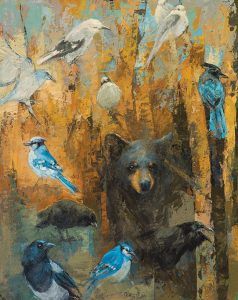
Mary Roberson, Corvids and Cub, oil, 50 x 40
At age 15 she was awarded a scholarship to attend Saturday classes at the Chouinard Art Institute (now the California Institute of the Arts) in Los Angeles. The training included life drawing of nude models, a disturbing concept for her devoutly Catholic mother. So her mother invited the parish priest for a visit, to speak with her daughter about the inappropriateness of that kind of activity. When the priest saw Mary’s artwork, though, he smiled. “This is great!” he said. He turned to her mother and gently explained, “Your daughter is approaching this from an artistic standpoint, and you’re not.” That took care of that.
Over the next few years Roberson also earned scholarships to study fine art at El Camino Junior College and Otis Art Institute in Los Angeles. Soon afterward, ready to leave the city’s concrete and crowds, she moved to a friend’s remote cabin on an Idaho lake. “Since I was there, I thought I would try painting the landscape,” she remembers. “I was painting and, lo and behold, a cowboy came by herding cattle, so I painted the cowboy and cattle and just loved it. It felt very natural.” Although she lived in the cabin for four or five years, she was unable to take full artistic advantage of the idyllic location; alcohol, with its attendant confusion and lack of self-worth, claimed a share of her attention at the time.
Then in 1991, everything changed. At age 43, Roberson was hospitalized after suffering a stroke. It was the jolt she needed to look hard at her life, especially at how her choices were affecting her children and her art. Within the span of a few days she quit smoking, quit drinking, and began proceedings for a divorce. “I’m that way—it’s all or nothing. I don’t do things humdrum or mediocre,” she says. “I thought, as long as I’m clearing things in my life and making adjustments and improvements, why not do it all?” One result was returning to painting with full focus for the first time in almost two decades.
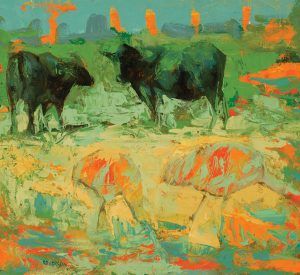
Mary Roberson, Angus and Cranes, oil, 20 x 22
A few years later Roberson was in Jackson, WY, exhibiting at an arts and crafts show. But she had grown tired of the festival circuit, of traveling and setting up a booth to sell her paintings, and one afternoon she followed her curiosity into a gallery. She showed the gallery director her work, which at the time included paintings of cattle. The director immediately offered to represent her. Then she asked, “Have you been to Yellowstone?” Roberson had not, so she headed there that very afternoon. As she drove into the park, the sun was setting and a bison ambled across the road. “I couldn’t leave. I stayed there two weeks, sleeping in my car and painting,” she says. “I just knew this was what I loved.”
In her studio these days Roberson usually has several paintings in process at once. She moves from one to another to let layers of oil paint dry, or to come back later and see a piece afresh, or to keep from overthinking a piece. She has learned that her approach to painting requires standing before her easel free of preconceived ideas—“sending the self away on sabbatical,” as she puts it—and following the artistic flow wherever it goes. “I just get a canvas and start, and creativity takes over,” she says. “I might put down a stroke of cerulean blue, and the next brush stroke will complement that. I can’t predict 5,000 brush strokes into the future, so how do I know where it will lead?”
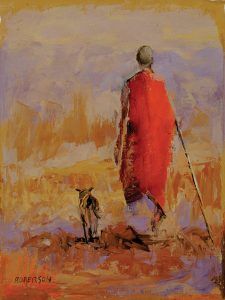
Mary Roberson, Maasai Man With His Dog, oil, 12 x 9.
Roberson also could not have guessed that her career would lead to artistic collaboration with her son. Four years ago, Dave Roberson, then 34, invited his mother to add animal imagery to some of the vessels he creates from hundreds of small pieces of wood combined and then masterfully turned to produce elegant forms. The equine shape is among the images Roberson has added to her son’s art. As both creature and symbol, horses have always held deep meaning for the artist. She associates them with freedom, a quality that is central in her life. Yet for years, painting horses did not come easily. “They were so important, and I tried to make them so real that I couldn’t paint them freely,” she says. Now she can, and the large-scale WILD HORSES is one such expression. “I never thought it would be this effortless to paint,” she says. “Now my brush just dances, or I use a big ol’ palette knife, and if it starts to look too controlled or static, I just wipe it all off.”
The small, richly hued painting MAASAI MAN WITH HIS DOG reflects Roberson’s interest in working quickly and intuitively. It is also a tribute to the humility, humor, and colorful dress of the Maasai people she met in Africa. “With this one, my challenge was to paint the dog without painting the dog,” she says. “I challenged myself to use as few strokes as possible, using primary colors and a palette knife.” The result was so aligned with her intention and reminiscent of her time in Africa that it found its way into her heart and into her own personal collection. While rendering the bright reds and blues of Maasai clothing “shifted my creativity” in those pieces, as she puts it, much of her art moves within a more limited tonal range. Combined with the amorphous quality of undefined backgrounds from which creatures and suggestions of their habitat emerge, the use of muted color imbues her imagery with a sense of wildness and mystery. It’s an appropriate effect for an artist who respects and appreciates the inherent mystery in life. At the same time, the beautiful aliveness of animals, whether in the wilderness or just outside her studio window, supercharges Roberson with delight about both art and the natural world. “Look at the oriole in the garden, sitting on a plant, eating insects—it’s so cool!” she says, interrupting her own thoughts. “I could be in the Tetons seeing a grizzly and this would still be just as fascinating to me.”
representation
Altamira Fine Art, Jackson, WY; Amsterdam Whitney Gallery, New York, NY; Gerald Peters Gallery, Santa Fe, NM; Visions West Galleries, Bozeman and Livingston, MT, and Denver, CO; Dick Idol Signature Gallery, Whitefish, MT.
Featured in the September 2016 issue of Southwest Art magazine. Get the Southwest Art September 2016 print issue or digital download now–then subscribe to Southwest Art and never miss another story.
- Mary Roberson, Angus and Cranes, oil, 20 x 22
- Mary Roberson, Blue Jay, oil, 8 x 8
- Mary Roberson, Corvids and Cub, oil, 50 x 40
- Mary Roberson, Maasai Man With His Dog, oil, 12 x 9.
- Mary Roberson, Tranquility, oil, 50 x 60.
- Mary Roberson, Wild Horses, oil, 36 x 60.
- Mary Roberson, Alpha and Cub, oil, 52 x 52.
- Mary Roberson, Barn Owl, oil, 12 x 12
- Mary Roberson, Big Brother Maasai, oil, 10 x 8.
- Mary Roberson, Carolina Wren, oil/encaustic, 8 x 10.
- Mary Roberson, Clark’s Nutcracker in the West, oil, 55 x 48.
- Mary Roberson, Partners in Nature, oil, 33 x 43.
- Mary Roberson, Retrospect, oil/encaustic, 24 x 24.
- Mary Roberson, Snowy Owl, oil, 12 x 12.
- Mary Roberson, Spring-Fed Marsh With Yellow-Headed Blackbirds, oil, 54 x 54.
- Mary Roberson, Symbiosis, oil, 20 x 30.
- Mary Roberson, Three Buddies, oil, 11 x 14.
- Mary Roberson, Tree Bear, oil, 30 x 30.
MORE RESOURCES FOR ART COLLECTORS & ENTHUSIASTS
• Subscribe to Southwest Art magazine
• Learn how to paint & how to draw with downloads, books, videos & more from North Light Shop
• Sign up for your Southwest Art email newsletter & download a FREE ebook






